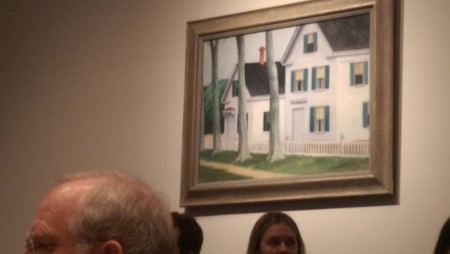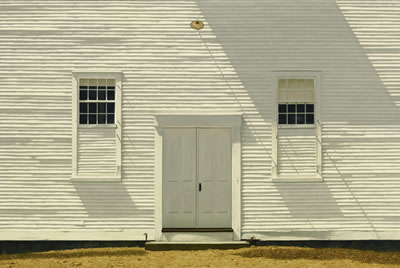If you look at my rules for collecting, you’ll see that one of them is “It is better to have a home run by a .200 hitter than a pop foul by Babe Ruth.” You’re not collecting autographs; you’re collecting paintings. Even the greatest artists had bad days. Last week at its American art auction, Christie’s tried to sell an autograph with a painting attached. (See below)
Two Puritans by Edward Hopper had an estimate of $20-30 million. It was a large oil, but I thought it was boring and a bit claustrophobic. It did not have the atmosphere of a great landscape such as Railroad Sunset or Lighthouse at Two Lights, let alone the psychological tension of one of Hopper’s city scenes. Collectors agreed with me, for bidding on this work went nowhere. The auctioneer gave up at $16.5 million, and I doubt that it was a real bid. He was probably “taking bids off the chandelier,” as the saying has it. What’s the painting worth, now that it has failed at auction — $8 million? $10 million? I think it will be a tough sell, even at those “modest” levels.
One lot that intrigued me was at Sotheby’s — Kenneth Davies’ Clapboards and Shadows. (See below.)
Davies, born in 1925, has long been a respected American realist, but his record price at auction during the past two years has been $11,250, with most lots going well below that. Sotheby’s placed a photo of this work on the back cover of the catalog, a place of honor, and gave it an estimate of $70,000-90,000. Based on what? It sometimes happens that auction results are not a true indicator of an artist’s market. One of the most extreme examples I can think of is John Rogers Cox (1915-1990), an Illinois artist whose record price at auction is $1,830. None of his marvelously spooky Surrealist landscapes, however, have been offered at auction. I know of two such works that have sold privately for over $300,000.
Is this the case with Davies? The painting above sold for $237,500. Was that indicative of what his major works have gone for privately, or was someone with a cache of Davies paintings trying to manipulate the market? I won’t name names, but certain dealers have been suspected of bidding a painting up through proxies to establish a new public benchmark, allowing them to ask more for the paintings by that artist that they have in their inventories. I’ll have to do some checking in this case. It will be interesting to see if the high price induces more owners of Davies’ paintings to put them at auction. That will be the true test. As we say in the trade, one high price is a record, two high prices are a trend, but it takes three high prices to make a market.



